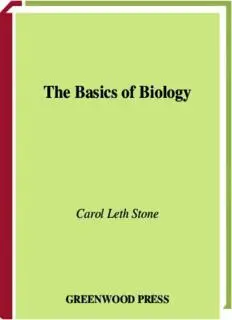
The Basics of Biology PDF
Preview The Basics of Biology
The Basics of Biology Carol Leth Stone GREENWOOD PRESS The Basics of Biology The Basics of Biology Carol Leth Stone Basics of the Hard Sciences Robert E. Krebs, Series Editor GREENWOOD PRESS Westport, Connecticut • London Library of Congress Cataloging-in-Publication Data Stone, Carol Leth. The basics of biology / Carol Leth Stone. p. cm. — (Basics of the hard sciences) Includes bibliographical references and index. ISBN 0–313–31786–0 (alk. paper) 1. Biology. 2. Human biology. I. Title. II. Series. QH307.2.S75 2004 570—dc22 2004008510 British Library Cataloguing in Publication Data is available. Copyright © 2004 by Carol Leth Stone All rights reserved. No portion of this book may be reproduced, by any process or technique, without the express written consent of the publisher. Library of Congress Catalog Card Number: 2004008510 ISBN: 0–313–31786–0 First published in 2004 Greenwood Press, 88 Post Road West, Westport, CT 06881 An imprint of Greenwood Publishing Group, Inc. www.greenwood.com Printed in the United States of America The paper used in this book complies with the Permanent Paper Standard issued by the National Information Standards Organization (Z39.48–1984). 10 9 8 7 6 5 4 3 2 1 In memory of Paul DeHart Hurd, teacher and friend. Contents Preface ix Acknowledgments xi Chapter 1 The Biosphere 1 From Organisms to Ecosystems 1 Changing Populations 20 Chapter 2 The Evolution of Life 25 Explaining Changes over Time 25 Explaining Geographic Similarities and Differences 34 Evolution by Natural Selection 46 Adaptations and Survival 48 The Human Species 54 The Origin of Life 59 Chapter 3 Cells and Genetics 63 The Study of Cells 64 Explaining Variations 74 Inheritance and Evolution 82 DNA, RNA, and Protein 85 Genetic Engineering and Biotechnology 90 Chapter 4 Organs and Systems 101 From Cells to Organ Systems 103 Using and Distributing Materials in the Body 105 Shielding and Supporting the Body 119 Sending Chemical and Electrical Signals in the Body 125 Creating a New Individual 136 viii Contents Chapter 5 A Survey of Organisms 143 The Beginnings of Classification 143 The Five-Kingdom System 146 Chapter 6 Humans in the Biosphere 179 Human Population Growth 180 Human Effects on Natural Resources 181 Science as a Human Endeavor 190 The Future of the Biosphere 191 Chapter 7 Investigations 201 The Biosphere 202 The Evolution of Life 203 Cells and Genetics 204 Organs and Systems 205 A Survey of Organisms 207 Humans in the Biosphere 208 Answers to Questions 211 Appendix 1. Investigating Biology on the Internet 215 Appendix 2. Units of Measurement: Metric System and English System 219 Appendix 3. Landmarks in Biology 221 Glossary 227 Selected Bibliography 249 For Further Reading 251 Index 257 Preface This book will describe what the living things on our world are like today, how they became what they are, and how their characteristics are passed from one genera- tion to the next. It will also show how living things interact with each other and with their nonliving surroundings. Never has the need for biology education been greater. We are continually bom- barded with new information about environmental problems, bacteriology, genetic engineering, drugs, health, and other biology-related topics. Yet few of us retain enough knowledge about basic biology to make informed decisions or even to read newspaper science articles intelligently. It is no longer possible—if it ever was—to provide a comprehensive survey of biology, but the material that follows will enable readers to read and evaluate arti- cles and books written for the general public. In addition, the investigations, sug- gestions for further reading, and list of Web sites can lead readers beyond this basic introduction. Readers will not become instant experts on biology, of course. This book is designed mainly as a reference work, to be used as needed for understanding the biological articles, books, and news programs that surround us. Readers should achieve at least a level of understanding that will enable them to read biology arti- cles in the New York TimesorScientific Americanwithout becoming confused. Chapter 1 gives an overview of ecology, providing a general picture of the bio- sphere and its inhabitants. In Chapter 2, evolution is presented as the process that has resulted in the biosphere of today. Chapter 3 discusses genetics, the molecular basis of variations that are the substrate for evolution. Body systems, especially human systems, are the subject of Chapter 4. In Chapter 5, the major classes of liv- ing organisms are surveyed. Completing the cycle, Chapter 6 returns to ecology, with emphasis on human ecology. The investigations or experiments in Chapter 7 have several purposes. Some provide additional concrete examples of ideas in the text; some help readers plan and carry out biological experiments; and some link the information in this book to events in the environment. Rather than being “cook- book” types of investigations, they are open-ended, encouraging readers to ask their
